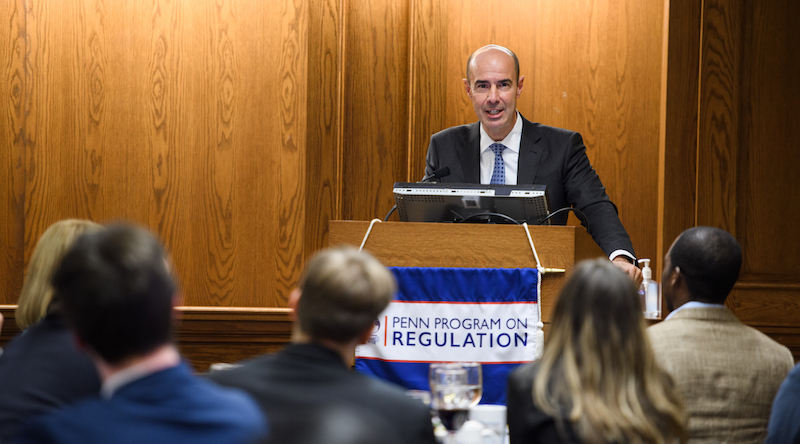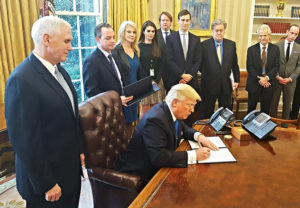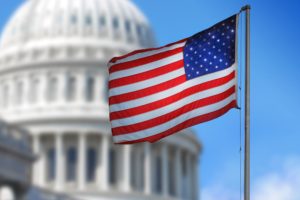
Public participation in the rulemaking process serves a vital role in improving the law.
Administrative law issues have ascended to the forefront of the national policy debate, as the Trump Administration pursues its agenda of regulatory reform. That agenda has renewed longstanding questions about the role of cost-benefit analysis in agency rulemaking decisions, the value of formal hearings over new significant regulations, and the constitutional authority of the president to order regulatory priorities. Underlying these questions lies a still more foundational question: What role should the public play in the regulatory process?
That question framed the 2017 Annual Penn Program on Regulation Lecture held at the University of Pennsylvania Law School. This year’s distinguished regulation lecture was delivered by Eugene Scalia, one of the nation’s foremost private practitioners in the administrative law arena.
A partner in the Washington, D.C. office of the law firm Gibson, Dunn & Crutcher, Scalia serves as the co-chair of the firm’s Administrative Law and Regulatory Practice Group—a role in which he has litigated a series of cases that have had important implications for administrative and regulatory law. In addition to his leading work in his capacity as a private attorney, Scalia previously served as Solicitor for the U.S. Department of Labor, where he was responsible for all Labor Department litigation stemming from the laws administered by the agency, including matters involving the Occupational Safety and Health Act, ERISA, the Family and Medical Leave Act, and the minimum wage and overtime provisions of the Fair Labor Standards Act.
In his lecture at Penn Law, Scalia addressed the role of the public—including advocacy groups, companies, and lawyers, among others—in agency rulemaking. He argued that public participation in the rulemaking process serves a vital role in improving the law by providing agency officials with important information and viewpoints that help them enhance their cost-benefit analysis and ultimately make better decisions.
Drawing on his extensive experience as an administrative law practitioner, Scalia recounted his involvement as a private lawyer challenging the adequacy of the U.S. Securities and Exchange Commission’s cost-benefit analysis of regulations—which ultimately resulted in judicial instruction that the Commission improve the quality of its regulatory analysis.
Scalia concluded his remarks by showing how the U.S. Supreme Court’s recent decision in Michigan v. EPA reinforced the value of public participation. In view of this decision, he explained that the rulemaking process serves to empower the public because it requires the government to take seriously ideas submitted during the comment period—and either to adopt those ideas or to provide a good explanation for declining to do so.
The Regulatory Review was honored to host Scalia at Penn Law, and we hope that his lecture, reproduced here in three parts, will inspire future discussion and debate about the administrative state and the public’s role in shaping it.
The Value of Public Participation in Rulemaking
September 25, 2017 | Eugene Scalia
Administrative law might seem an obscure and dry topic to some, but at bottom, its subject is government and democracy. Outsiders play a crucial role in our system of administrative law—that is, companies, unions, environmental groups, and others, including lawyers. As the administrative state expands and Congress punts more—and more difficult—policy questions to agencies, it is often by appearing before those agencies that the public participates in the development—and improvement—of the law.
Cost-Benefit Analysis and Reasoned Agency Decision-Making
September 26, 2017 | Eugene Scalia
A number of academics have concluded that the D.C. Circuit has demanded too much of financial regulatory agencies, and some have suggested that requiring cost-benefit analysis of financial rules is too tall an order. To be sure, there are limits to the economic analysis that can be performed on any rule. But the U.S. Securities and Exchange Commission 10 years ago was not pushing those limits—it was not trying to engage in a genuine analysis of the economic effects of its rules at all.
Concluding Thoughts on Cost-Benefit Analysis and the Public’s Impact in Rulemaking
September 27, 2017 | Eugene Scalia
The upshot of the recent Supreme Court decision, Michigan v. EPA, is that some form of cost-benefit analysis is appropriate in almost every rulemaking. For the public, the case also reflects an empowering point about the rulemaking process: if the public cogently presents an idea in a comment, the government must give that idea consideration and either adopt it or give a sensible explanation for not doing so. In this way, the public can help shape the agency’s duties in a rulemaking through the substance of the record evidence and comments they supply.



